
A shrub or bush is a small-to-medium-sized perennial woody plant. Unlike herbaceous plants, shrubs have persistent woody stems above the ground. Shrubs can be either deciduous or evergreen. They are distinguished from trees by their multiple stems and shorter height, less than 6–10 m (20–33 ft) tall. Small shrubs, less than 2 m (6.6 ft) tall are sometimes termed as subshrubs. Many botanical groups have species that are shrubs, and others that are trees and herbaceous plants instead.

An arboretum is a botanical collection composed exclusively of trees of a variety of species. Originally mostly created as a section in a larger garden or park for specimens of mostly non-local species, many modern arboreta are in botanical gardens as living collections of woody plants and is intended at least in part for scientific study.

The Government Botanical Garden is a botanical garden in Udhagamandalam, near Coimbatore (Ooty), Tamil Nadu state, India laid out in 1848. The gardens, divided into several sections, cover an area of around 22 hectares, and lie on the lower slopes of Doddabetta peak. The garden has a terraced layout. It is maintained by the Tamil Nadu Horticulture Department.

The University of Delaware Botanic Gardens are botanical gardens and an arboretum located on the campus of the University of Delaware, in Newark, Delaware, United States. The gardens are open to the public without charge.

The Donald E. Davis Arboretum, in Auburn, Alabama, United States, is a public native plants museum, and botanical arboretum with educational facilities, event spaces, and a conservation program. Its grounds, covering 13.5 acres of Auburn University's campus, include cataloged living collections of associated tree and plant communities representative of Alabama's ecosystems, among which is mixed oak forest, carnivorous bog, and longleaf pine savanna. The living collections include more than 1,000 plant types, including 500 different plant species, with over 3,000 cataloged specimens. The Arboretum contains over a mile (2 km) of interwoven walking trails that meander through various southeastern biotopes.

Bickelhaupt Arboretum is a non-profit arboretum located in Clinton, Iowa. It is open dawn to dusk daily without charge.
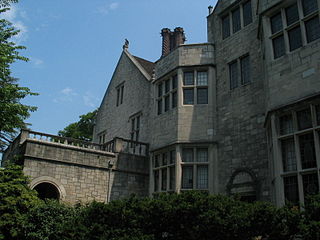
Planting Fields Arboretum State Historic Park, which includes the Coe Hall Historic House Museum, is an arboretum and state park covering over 400 acres (160 ha) located in the village of Upper Brookville in the town of Oyster Bay, New York.

Nichols Arboretum, locally known as the Arb, is an arboretum operated by the Matthaei Botanical Gardens and Nichols Arboretum (MBGNA) at the University of Michigan. Located on the eastern edge of its Central Campus at 1610 Washington Heights in Ann Arbor, Michigan, the Arboretum is a mosaic of University and City properties operated as one unit. The arboretum is open daily from sunrise to sunset with no charge for admission. The Huron River separates a northern section of the arboretum's floodplain woods; the railroad marks the northern border.
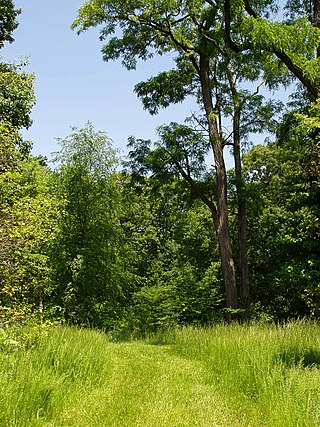
Rutgers Gardens is the official botanical garden of Rutgers University, located on the outskirts of Rutgers School of Environmental and Biological Sciences, at 112 Log Cabin Road, North Brunswick, New Jersey, 08902. The grounds include 60 acres of designed beds, specialty gardens, tree and shrub collections, lawns, and walking paths, and the adjoining 70-acre Frank G. Helyar Woods. The gardens are open year-round, without fee, and feature horticultural collections arranged in garden settings. In 2017 it was granted landmark status by the American Society for Horticultural Science.

The JC Raulston Arboretum is a 10-acre (40,000 m2) arboretum and botanical garden administered by North Carolina State University, and located in Raleigh, North Carolina. It is open daily to the public without charge.

Tyler Arboretum is a nonprofit arboretum located at 515 Painter Road, Middletown Township, Delaware County, Pennsylvania. It is open daily except for major holidays; an admission fee is charged to non-members.
The Plant Collections Network (PCN) is a group of North American botanical gardens and arboreta that coordinates a continent-wide approach to plant germplasm preservation, and promotes excellence in plant collections management. The program is administered by the American Public Gardens Association from its headquarters in Kennett Square, Pennsylvania, in collaboration with the USDA Agricultural Research Service.

The Morris Arboretum & Gardens of the University of Pennsylvania is the official arboretum of the Commonwealth of Pennsylvania. The Arboretum is open daily except for major holidays. It is located at 100 East Northwestern Avenue, Chestnut Hill, Philadelphia, Pennsylvania.
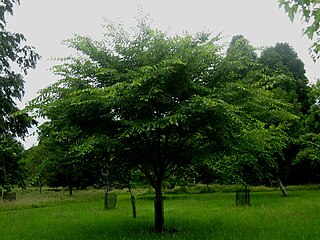
Ulmus davidiana, also known as the David elm, or Father David elm, is a small deciduous tree widely distributed across China, Mongolia, Korea, Siberia, and Japan, where it is found in wetlands along streams at elevations of 2000–2300 m (6,500–7,500 ft). The tree was first described in 1873 from the hills north of Beijing, China.
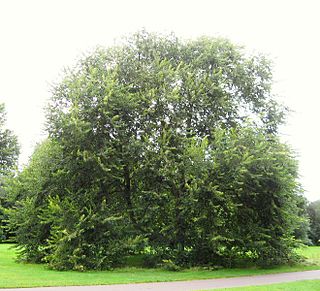
Ulmus villosa, the cherry-bark elm or Marn elm, is one of the more distinctive Asiatic elms, and a species capable of remarkable longevity. It is endemic to the valleys of the Kashmir at altitudes of 1,200–2,500 metres but has become increasingly rare owing to its popularity as cattle fodder. Mature trees are now largely restricted to temples and shrines where they are treated as sacred. Some of these trees are believed to be over 800 years old.
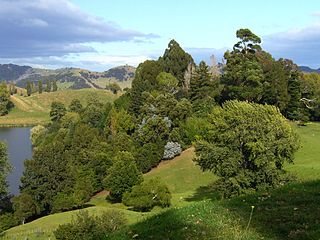
Hackfalls Arboretum is an arboretum in New Zealand. It was founded in the 1950s by Bob Berry. It is part of Hackfalls Station, a sheep and cattle farm of about 10 square kilometres, owned by the Berry family. The farm is in Tiniroto, a tiny village in the eastern part of the North Island, between Gisborne (town) and Wairoa.
The arboretum covers 0.56 km2, along the borders of two lakes, and has about 3,500 species of trees and shrubs. It includes many different oaks "spaced in rolling pastureland, allowing each to develop fully, and limbed up to enable grass to grow underneath". The most important part of the collection is about 50 different taxa of Mexican oaks.
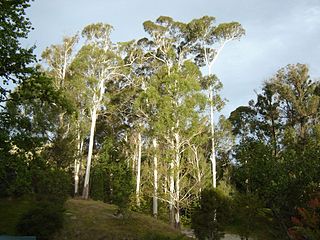
Eastwoodhill is the national arboretum of New Zealand. It covers 131 hectares (1.31 km2) and is located 35 km northwest of Gisborne, in the hill country of Ngatapa. It was founded in 1910 by William Douglas Cook. Cook's life work would become the creation of a giant collection of Northern Hemisphere temperate climate zone trees in New Zealand – a dream that would eventually cost him all his money – buying and importing thousands of trees from New Zealand and British nurseries.

Wojsławice Arboretum is an arboretum, located in Wojsławice, Dzierżoniów County, Lower Silesian Voivodeship, in south-western Poland. It occupies an area of 62 ha.
Ulmus boissieriGrudz.,, a disputed species of elm found in Iran, was identified by Grudzinskaya in 1977. She equated her "new species" with the U. campestris f. microphylla collected in 1859 in Kerman Province and described in his Flora Orientalis (1879) by Boissier, for whom she named it, treating Boissier's specimen as the "type". The tree is endemic the provinces of Kermanshah and Kerman., and also the Zagros forests, growing with Quercus brantii, Celtis australis, Platanus orientalis, Fraxinus sp., and Cerasus mahaleb.

Arboretum Wespelaar is an arboretum in Wespelaar, Belgium.






















